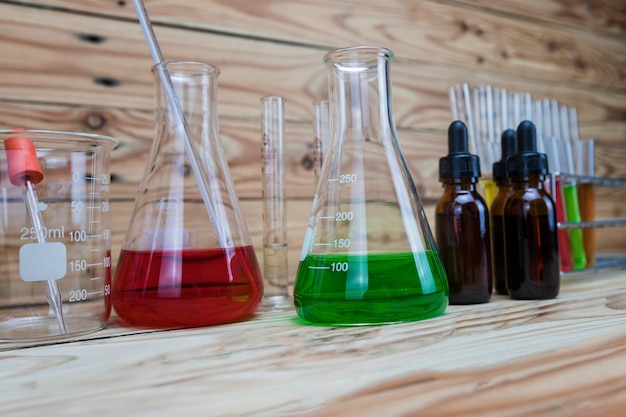

They are made of pyrex and may be heated. They are not to be used for volume measurements when accuracy is important. Beaker Beakers are roughly graduated and may be used for estimating the volume of a liquid.

Usually you can get around the problem of wet volumetric glassware by rinsing it with 4 or 5 small aliquots of the solution to be measured so the solution replaces the water. Do not heat volumetric glassware (it will break if you do). If you must dry the inside of a flask, warm it gently over a Bunsen burner. Glass is easier to clean immediately after use than after it has dried dirty! You rarely need to dry glassware.

Rinsing with many small portions is more effective (and cheaper) than with a few big ones. Finally, rinse 5 or 6 times with small amounts of distilled or deionized water. Be sure there are no exposed, sharp, metal points on the brush which can scratch the glass. Never put solid soap into glassware with narrow channels. To clean glassware, put detergent into a bucket and add hot water. If you see droplets on the glass, the glass is not clean. All volumetric glassware and flasks used for reactions should be thoroughly cleaned. A beaker used to hold ice for an ice bath doesn't need to be very clean. We hope this brief crash course in science lingo helps you to sound smarter among your peers.How To Use The Glassware Cleaning and Drying Glassware Determine how much time you spend cleaning a piece of glassware by thinking about its use. Both are used during chemical reactions, and both are essential to a successful lab.

Both are made from either glass or clear plastic, most are graduated- meaning they have markings on the side indicating the amount of liquid they contain. The spout on beakers makes pouring their contents easy, which makes them invaluable for performing experiments.įlasks and beakers do share some characteristics. Beakers are mainly for measuring and transporting liquids from one site to the next. The main differing characteristic between a flask and a beaker is that beakers have straight sides, rather than slanted sides like a flask. These are also used when performing experiments, to hold various liquids for either mixing or disposal. Furthermore, flasks have the ability to be capped or corked, therefore solutions can be held for long periods of time without risk of spilling.īeakers, on the other hand, are cylindrical containers with a flat bottom and a spout on top. Flasks are normally the site of chemical reactions, for the reaction can take place in the large vessel and have low risk of spilling due to the long, narrow neck of the flask. Flasks can be used for holding and measuring solutions, as well as for chemical reactions and phase changes (heating, cooling, etc). While both tools are often used in a science lab, they are actually quite different.įlasks are notable for their unique shape: a rounded vessel and a cylindrical neck. Many people outside the science world use the terms ‘flask’ and ‘beaker’ interchangeably.
#Flask vs beaker how to#
Sorting through nerdy jargon: how to sound like a real scientist.


 0 kommentar(er)
0 kommentar(er)
